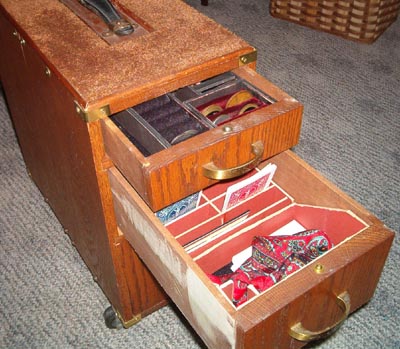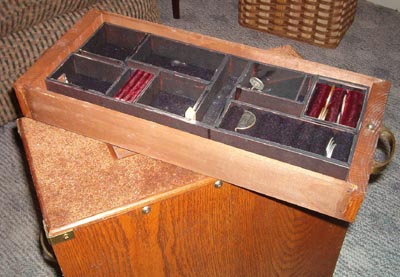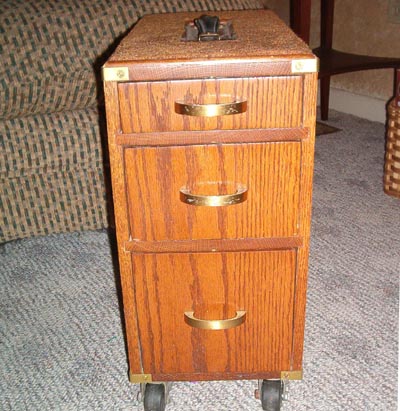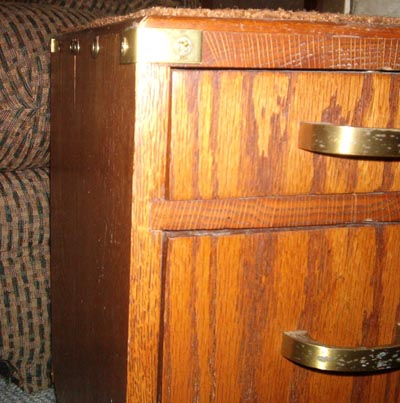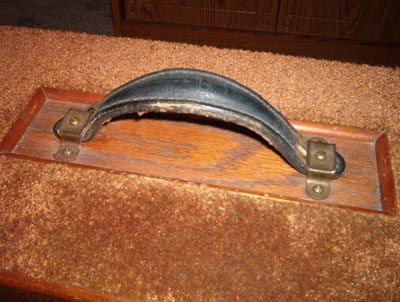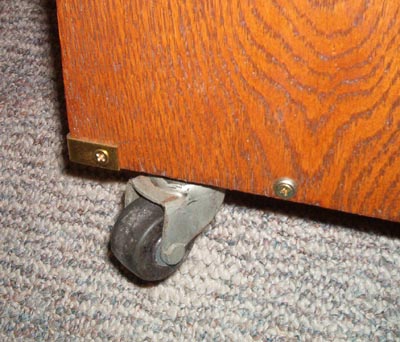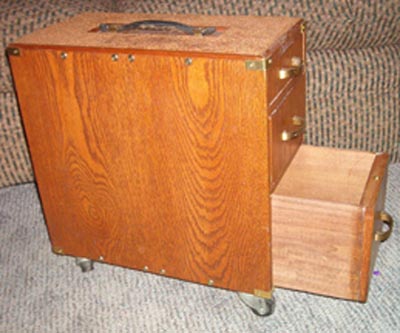
In the early 1980's, Greg McNeil and I built 3 of these seat-cases. We each built our own, and worked together on the third which was sold to Steve Spain, a Peoria, IL magic dealer.
Greg did the basic case design, based upon an existing concept. We each then added our own details to our own liking. We had seen others that either had 2 equal sized drawers, or 4 equal sized half drawers (2 from each end). What we saw with the other designs was first, with drawers the same depth, smaller items could easily get lost, falling to the bottom of the drawers. Secondly, the drawers could easily and accidentally be pulled completely out of the case, possibly spilling everything inside, if you attempted to get something that was far to the back of the drawer.
Our new design had full-length drawers, which could be accessed from either end. I designed my case with different sets in the opposite ends of the case. It just depended on which way I placed the case down before sitting on it. Bullet catches latched the drawers securely closed. There are three drawers of varying sizes to accomodate a variety of props. The smallest drawer, at the top, was deep enough to hold coins up to Silver Dollar size, standing upright on edge. The middle drawer was deep enough to hold decks of cards or chop cups upright. The bottom drawer was reserved for anything that would not fit comfortably in the other drawers. For some time, I actually carried a large rock for production in the bottom drawer.
The cases were made from 1/2" red oak (3/4" for the drawer fronts), with 1/4" poplar for the drawer sides. They are fairly heavy, but very durable, and were designed to look like pieces of fine furniture. The original idea was to assemble the pieces entirely with wood glue. Mine was the only one that performed that well initially. Due to slight warping, the other two had to be reinforced with screws. A few years after I had moved to Birmingham, AL from Illinois, and because of the constantly humid climate, mine began to experience those problems, as well. At that time, I reinforced mine with screws and corner braces. It lasted about 15 years before needing that, and I expect it will last for a long, long time now.
The shelves that support the drawers are set into dados, as are the top and bottom. The top is covered with a low pile, dense plush carpet. It was framed around the perimeter and inside the handle opening with 1/4" quarter-round trim. Originally, I also had a close-up pad made from the same carpet. The edges were finished with cloth binding tape and the back was coated with latex rug-backing compound that had been dyed black with acrylic paint. Small "D" rings attached to the corners hooked to small brass loop hooks on the side of the case, so the pad could be stored flat against the side when not in use.
The handle was of heavy leather, in order to lay flat when not in use, and be comfortable when sitting on the case. They were obtained from Ohio Travel Bag Company, a company that sold a variety of cool trunk and suitcase parts. The casters also came from the same company. These particular casters were chosen because they were of a small diameter, thereby keeping the height of the case at standard chair height, while allowing more room for storage. Because they were rated for a few hundred pounds, it assured us we weren't going to break them by sitting on the case and rolling forward or backward.
After hours of sanding, the cases were stained with a cherry stain and hand rubbed with Tung Oil to a satin finish. The drawer handles are solid brass.
Detailing the interiors of the drawers was a personal endeavor. I constructed compartments from mat-board, that held all the items I was using at that time. They were made as units and could be changed around, if needed. The bottom of the drawers were lined with black felt.
I made a cover for mine of black vinyl, that kept the finish protected during travel, and also assured that the sliding drawers couldn't accidentally open.

